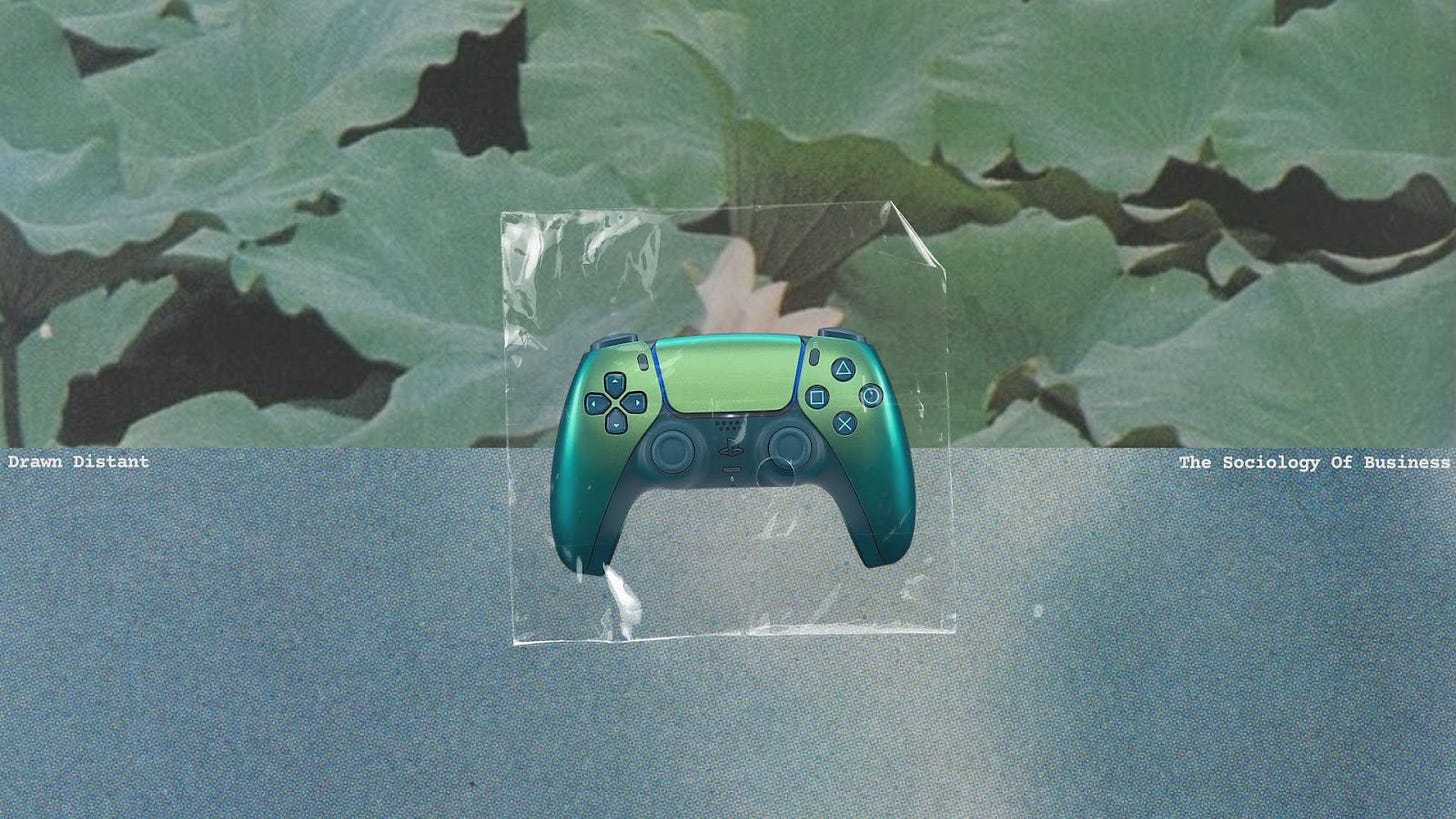Why Gaming Needs to Become a Channel in Your Marketing Mix
It’s time to stop treating it like a stunt
Originally published with Ana Andjelic on The Sociology of Business.
By now, you’ve probably heard it all: “Gaming is the new social media.” “Gen Z and Gen Alpha spend more time in games than on TikTok.” “Gaming is bigger than the film and music industry combined.” Cue the headline ticker, cue the CMO nodding cautiously while someone says “metaverse” again hoping that doesn’t mean they have to dust off the half baked NFT strategy from 2021.
And yet, when it comes to actual marketing strategy? Gaming still gets treated like a flashy side quest — a brand stunt, a Q4 wildcard, a “break glass in case” we don’t resonate with those pesky Zoomers. It’s where ideas go when someone wants to try something fun, not drive business impact.
Let’s be clear: gaming isn’t confined to button mashing anymore. It is the moment. Want to join an ICE protest in LA but you live elsewhere? Try Roblox. Dying to see Sabrina Carpenter but her tour doesn’t stop in your home town? Try Fortnite.
Gaming is a fully-fledged media channel with persistent reach, proven conversions, and cultural spillover that would make a Super Bowl ad blush.
So why are brands still acting like it’s a novelty?
Triple-A Games And The Data Desert
While the impact of gaming is undeniable, the measurement of it has historically been elusive. Tracking a campaign through Meta, TikTok or YouTube? Then you have state of the art insights tools at your disposal. Tracking a campaign inside a Triple A video game? Well…not as seamless.
“The Gentle Monster x Tekken collab was a cultural uppercut — but did it hit below the line? Without readily available tracking, it’s hard to say.
Why is this? Deep brand integrations into games is still a relatively recent phenomenon. Of course, we’ve had clunky “advergames” (turned surprising cult classics) like Pepsi Man on the PS1 back in. We even saw Obama ads inside of MADDEN 09, NASCAR and Burnout back in 2009.
Commercials in games is nothing new, but organic brand immersion via skins, mini-games, experiences and collaborations - this has only been happening at scale for the last 5-10 years, so a lot of Triple A games are still playing catch up.
But things are changing.
Roblox – the bellwether of gaming brand integrations – continues to build out a comprehensive suite of tracking tools with major partners like Nielsen, Google and Shopify. Fortnite just recently announced their own open data API - a game that has typically favoured finger in the wind measurement over deep insights. Industry leaders like GEEIQ offer full-funnel marketing dashboards that go beyond standard metrics of clickability and viewership - helping brands make clearer decisions about what games are right for them and why.
Games are reacting to their role as social media platforms, and building the tools to complement. So how do brands boot up?
Building With One Block(buster) At A Time
When it comes to getting started, the proven move is to go direct to Roblox, Fortnite and Minecraft. And why wouldn’t you? They’re bonafide ecosystems with loyal fanbases, built-in creator economies, and enough cultural cross-pollination to power the next wave of memes, music and merch. Brands shouldn’t just integrate into these platforms, they should find ways to break them open. Free the NPC!
Take Roblox’s Grow A Garden — a farming sim turned youth culture monolith. In June 2025, it pulled in a record-breaking 21 million concurrent players, more than Fortnite (at the time), and more than the top five games on Steam combined. It has a sea of TikTok content and a thriving secondary marketplace. It’s only a matter of time before we see a BRAT-esque brand integration like we saw last year with Roblox’s game-du-jour of 2024 - Dress To Impress.
Fortnite isn’t just attracting global musicians like Ice Spice and Sabrina Carpenter inside the game, it’s incubating their own. Billboard chart-topping artist D4VD got his first fans inside Fortnite. Now he’s headlining Coachella. Imagine nurturing a creative talent like this as they rise beyond the Battle Royale?
These platforms aren’t self-contained. They echo outwards. What happens in-game doesn’t stay in-game — it hits TikTok, red carpets, runways, and radio. Engaging here isn’t about being in a game — it’s about becoming a catalyst for the culture that forms around it.
Thinking Outside The Blox: Cult Games, Cult Fandoms, Cult Conversions
Much like music and film, gaming has its blockbusters — and its cult classics. The best of the best are both. While Roblox and Fortnite are easy wins for reach, the deeper layers of gaming (and their titles) hold their own marketing power. These aren’t just games — they’re IP incubators.
The Last of Us proved that cinematic storytelling in games can fuel prestige TV. Clair Obscur: Expedition 33’s soundtrack broke into the Billboard Classical Albums chart with 18M+ streams and a top 15 download debut.
Even A24 — high priest of indie film cool — is getting in on the action, announcing an Elden Ring adaptation with Alex Garland. When the arbiters of niche culture start investing in fantasy dungeon crawlers, it’s a sign that there’s something bigger at play.
These titles have fandoms that run deep, the kind of energy marketers dream of. While they may not have the readily accessible measurement tools that the game-come-social-media-platform types like Roblox and Fortnite do, they offer brands a chance to show up in unexpected, meaningful ways.
Cult Meets Commercial: The Brand Getting It Right
Nike’s .SWOOSH: The Gaming Multiverse
Nike hasn’t just dipped its toe into gaming, it dove in headfirst with its sneakers still on. After sunsetting its NFT experiment RTFKT, Nike repositioned .SWOOSH away from a Web3 project into a cross-platform gaming strategy.
In 2024 alone, Nike:
Signed Kai Cenat as their first ever gaming streamer, making him the face of the Nike Air Max Low Poly 1’s.
Partnered with Fortnite as the launch partners of KICKS - their fully fledged footwear marketplace.
Created a dedicated Nike stadium inside EA FC 25, pushing the boundaries of what a football stadium could be.
Created the Foamposite One Tekken 8 Jin Kazama for the legacy gamers.
SWOOSH doesn’t treat gaming like a cameo. It takes the lead role. They build presence across multiple titles, using gaming not just for eyeballs — but for storytelling, engagement, and digital wearables that convert. It’s a balance between cult and commercial - something akin to Nike’s overall business strategy.
Don’t Just Game the System. Build One.
It’s understandable why some marketers have hesitated with gaming. Development sounds expensive. Measurement once felt murky. ROI into real world commercial success has been a grey zone. But we’ve come a long way.
Building a creator island in Fortnite now has the same trackability as a YouTube pre-roll or a paid IG post. The metrics are here. The tools exist. The audience is already playing.
A recent McKinsey report shows that console and PC gaming deliver exceptional attention value. It’s the only digital medium that gets close to live levels of focus (high focus: 73%), far higher than other forms of video-based content like streaming video (57%).
So stop treating gaming like a flash-in-the-pan experiment. Build the damn department. Make it a real channel in your marketing mix.
Build a good ad? People might share it for a few weeks.
Build a good game? People might play it for a few years.
So stop hiring the pixel stuntman for that Q4 Hail Mary. Make them the main character.





